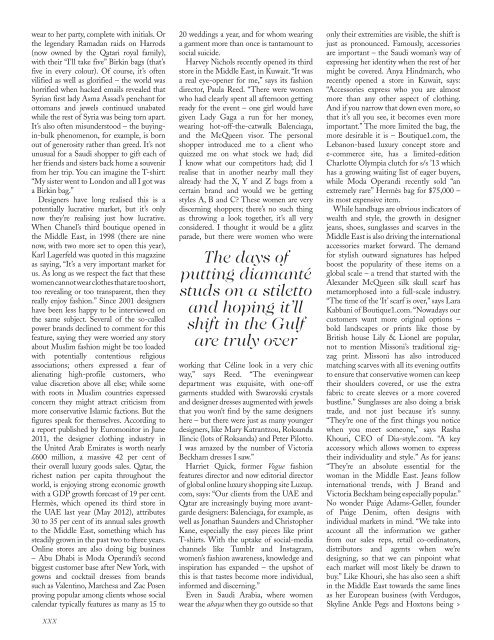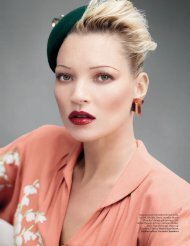MATADIN/TRUNK
Beyond the Veil - Kathleen Baird-Murray
Beyond the Veil - Kathleen Baird-Murray
- No tags were found...
Create successful ePaper yourself
Turn your PDF publications into a flip-book with our unique Google optimized e-Paper software.
wear to her party, complete with initials. Or<br />
the legendary Ramadan raids on Harrods<br />
(now owned by the Qatari royal family),<br />
with their “I’ll take five” Birkin bags (that’s<br />
five in every colour). Of course, it’s often<br />
vilified as well as glorified – the world was<br />
horrified when hacked emails revealed that<br />
Syrian first lady Asma Assad’s penchant for<br />
ottomans and jewels continued unabated<br />
while the rest of Syria was being torn apart.<br />
It’s also often misunderstood – the buyingin-bulk<br />
phenomenon, for example, is born<br />
out of generosity rather than greed. It’s not<br />
unusual for a Saudi shopper to gift each of<br />
her friends and sisters back home a souvenir<br />
from her trip. You can imagine the T-shirt:<br />
“My sister went to London and all I got was<br />
a Birkin bag.”<br />
Designers have long realised this is a<br />
potentially lucrative market, but it’s only<br />
now they’re realising just how lucrative.<br />
When Chanel’s third boutique opened in<br />
the Middle East, in 1998 (there are nine<br />
now, with two more set to open this year),<br />
Karl Lagerfeld was quoted in this magazine<br />
as saying, “It’s a very important market for<br />
us. As long as we respect the fact that these<br />
women cannot wear clothes that are too short,<br />
too revealing or too transparent, then they<br />
really enjoy fashion.” Since 2001 designers<br />
have been less happy to be interviewed on<br />
the same subject. Several of the so-called<br />
power brands declined to comment for this<br />
feature, saying they were worried any story<br />
about Muslim fashion might be too loaded<br />
with potentially contentious religious<br />
associations; others expressed a fear of<br />
alienating high-profile customers, who<br />
value discretion above all else; while some<br />
with roots in Muslim countries expressed<br />
concern they might attract criticism from<br />
more conservative Islamic factions. But the<br />
figures speak for themselves. According to<br />
a report published by Euromonitor in June<br />
2011, the designer clothing industry in<br />
the United Arab Emirates is worth nearly<br />
£600 million, a massive 42 per cent of<br />
their overall luxury goods sales. Qatar, the<br />
richest nation per capita throughout the<br />
world, is enjoying strong economic growth<br />
with a GDP growth forecast of 19 per cent.<br />
Hermès, which opened its third store in<br />
the UAE last year (May 2012), attributes<br />
30 to 35 per cent of its annual sales growth<br />
to the Middle East, something which has<br />
steadily grown in the past two to three years.<br />
Online stores are also doing big business<br />
– Abu Dhabi is Moda Operandi’s second<br />
biggest customer base after New York, with<br />
gowns and cocktail dresses from brands<br />
such as Valentino, Marchesa and Zac Posen<br />
proving popular among clients whose social<br />
calendar typically features as many as 15 to<br />
XXX<br />
20 weddings a year, and for whom wearing<br />
a garment more than once is tantamount to<br />
social suicide.<br />
Harvey Nichols recently opened its third<br />
store in the Middle East, in Kuwait. “It was<br />
a real eye-opener for me,” says its fashion<br />
director, Paula Reed. “There were women<br />
who had clearly spent all afternoon getting<br />
ready for the event – one girl would have<br />
given Lady Gaga a run for her money,<br />
wearing hot-off-the-catwalk Balenciaga,<br />
and the McQueen visor. The personal<br />
shopper introduced me to a client who<br />
quizzed me on what stock we had; did<br />
I know what our competitors had; did I<br />
realise that in another nearby mall they<br />
already had the X, Y and Z bags from a<br />
certain brand and would we be getting<br />
styles A, B and C? These women are very<br />
discerning shoppers; there’s no such thing<br />
as throwing a look together, it’s all very<br />
considered. I thought it would be a glitz<br />
parade, but there were women who were<br />
The days of<br />
putting diamanté<br />
studs on a stiletto<br />
and hoping it’ll<br />
shift in the Gulf<br />
are truly over<br />
working that Céline look in a very chic<br />
way,” says Reed. “The eveningwear<br />
department was exquisite, with one-off<br />
garments studded with Swarovski crystals<br />
and designer dresses augmented with jewels<br />
that you won’t find by the same designers<br />
here – but there were just as many younger<br />
designers, like Mary Katrantzou, Roksanda<br />
Ilincic (lots of Roksanda) and Peter Pilotto.<br />
I was amazed by the number of Victoria<br />
Beckham dresses I saw.”<br />
Harriet Quick, former Vogue fashion<br />
features director and now editorial director<br />
of global online luxury shopping site Luxup.<br />
com, says: “Our clients from the UAE and<br />
Qatar are increasingly buying more avantgarde<br />
designers: Balenciaga, for example, as<br />
well as Jonathan Saunders and Christopher<br />
Kane, especially the easy pieces like print<br />
T-shirts. With the uptake of social-media<br />
channels like Tumblr and Instagram,<br />
women’s fashion awareness, knowledge and<br />
inspiration has expanded – the upshot of<br />
this is that tastes become more individual,<br />
informed and discerning.”<br />
Even in Saudi Arabia, where women<br />
wear the abaya when they go outside so that<br />
only their extremities are visible, the shift is<br />
just as pronounced. Famously, accessories<br />
are important – the Saudi woman’s way of<br />
expressing her identity when the rest of her<br />
might be covered. Anya Hindmarch, who<br />
recently opened a store in Kuwait, says:<br />
“Accessories express who you are almost<br />
more than any other aspect of clothing.<br />
And if you narrow that down even more, so<br />
that it’s all you see, it becomes even more<br />
important.” The more limited the bag, the<br />
more desirable it is – Boutique1.com, the<br />
Lebanon-based luxury concept store and<br />
e-commerce site, has a limited-edition<br />
Charlotte Olympia clutch for s/s ’13 which<br />
has a growing waiting list of eager buyers,<br />
while Moda Operandi recently sold “an<br />
extremely rare” Hermès bag for $75,000 –<br />
its most expensive item.<br />
While handbags are obvious indicators of<br />
wealth and style, the growth in designer<br />
jeans, shoes, sunglasses and scarves in the<br />
Middle East is also driving the international<br />
accessories market forward. The demand<br />
for stylish outward signatures has helped<br />
boost the popularity of these items on a<br />
global scale – a trend that started with the<br />
Alexander McQueen silk skull scarf has<br />
metamorphosed into a full-scale industry.<br />
“The time of the ‘It’ scarf is over,” says Lara<br />
Kabbani of Boutique1.com. “Nowadays our<br />
customers want more original options –<br />
bold landscapes or prints like those by<br />
British house Lily & Lionel are popular,<br />
not to mention Missoni’s traditional zigzag<br />
print. Missoni has also introduced<br />
matching scarves with all its evening outfits<br />
to ensure that conservative women can keep<br />
their shoulders covered, or use the extra<br />
fabric to create sleeves or a more covered<br />
bustline.” Sunglasses are also doing a brisk<br />
trade, and not just because it’s sunny.<br />
“They’re one of the first things you notice<br />
when you meet someone,” says Rasha<br />
Khouri, CEO of Dia-style.com. “A key<br />
accessory which allows women to express<br />
their individuality and style.” As for jeans:<br />
“They’re an absolute essential for the<br />
woman in the Middle East. Jeans follow<br />
international trends, with J Brand and<br />
Victoria Beckham being especially popular.”<br />
No wonder Paige Adams-Geller, founder<br />
of Paige Denim, often designs with<br />
individual markets in mind. “We take into<br />
account all the information we gather<br />
from our sales reps, retail co-ordinators,<br />
distributors and agents when we’re<br />
designing, so that we can pinpoint what<br />
each market will most likely be drawn to<br />
buy.” Like Khouri, she has also seen a shift<br />
in the Middle East towards the same lines<br />
as her European business (with Verdugos,<br />
Skyline Ankle Pegs and Hoxtons being ><br />
03-13veilVO42539.indd 3 24/01/2013 11:44




